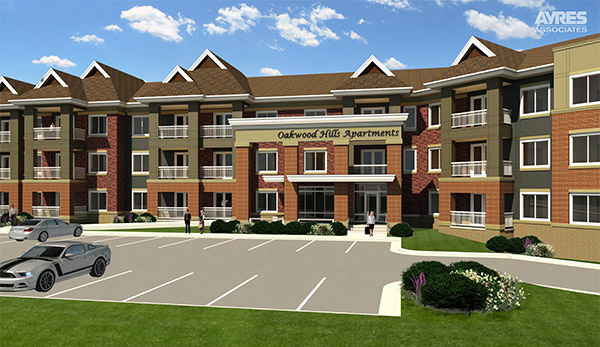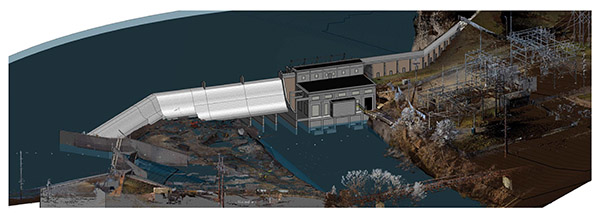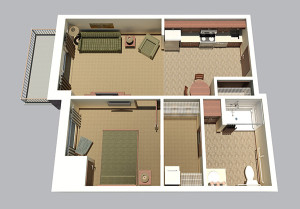Revit Gives Inside Look at Building Plans
 So you’ve decided you need a new facility. You can look at other buildings that you like, and you have an idea in mind of what yours will look like – but until it’s actually built, you may expect to see only line drawings and elevations to help with the planning. It’s how architects have done it for centuries – but today’s architects have a better way. With Revit, a Building Information Modeling software, you can get an early look at how your building will look and function – and save yourself time and headaches by making changes during design, not construction.
So you’ve decided you need a new facility. You can look at other buildings that you like, and you have an idea in mind of what yours will look like – but until it’s actually built, you may expect to see only line drawings and elevations to help with the planning. It’s how architects have done it for centuries – but today’s architects have a better way. With Revit, a Building Information Modeling software, you can get an early look at how your building will look and function – and save yourself time and headaches by making changes during design, not construction.
Here’s how:
1. Revit lets you see what your building will look like – in 3-D. The AutoCAD line drawings – plain and, if you don’t have a construction background, confusing – are swiftly becoming a thing of the past. Clients love Revit; instead of a 2-D line drawing, they get a much more understandable 3-D model that allows them to really get involved. Since the models can be turned, moved, or sliced into cross sections, it gives you a vivid picture of what your building will look like. Not only does this let you see exactly what to expect, it makes an extremely convincing presentation to show to boards of directors, city councils, and other stakeholders.
 Additionally, architects and designers can team up with surveyors to get HD laser scans of a site and use point-cloud technology to create an extremely detailed 3-D environment of the surrounding area. This means the information put into the Revit model is accurate and reflects the exact conditions of a site – which comes in handy if you’re renovating an old building or have a difficult site. The image above shows the Revit model of the Byllesby Dam in Dakota County, Minnesota; HD laser scans provided the data to create the model.
Additionally, architects and designers can team up with surveyors to get HD laser scans of a site and use point-cloud technology to create an extremely detailed 3-D environment of the surrounding area. This means the information put into the Revit model is accurate and reflects the exact conditions of a site – which comes in handy if you’re renovating an old building or have a difficult site. The image above shows the Revit model of the Byllesby Dam in Dakota County, Minnesota; HD laser scans provided the data to create the model.
2. Revit enhances the design process. Revit has advantages over other design software when it comes to creating a visual that is easy to understand. That allows clients to have involvement early on. 
Sitting down with a designer at the beginning and having an easily understandable model can save time in the design process – you can have more efficient meetings where you can see immediately what it looks like to have a window added or a different roof design. The model will adjust the floor plans, sections, and elevations with the change, allowing you to see if changes are possible or if they create conflicts with any other part of the building, such as the mechanical components.
3. The goal of Revit is to reduce errors. Its Interference Report software helps designers locate and resolve issues before construction, such as mechanical ductwork interfering with a structural beam. It picks up each modeled component and shows you exactly where the problem is. It saves time and money when you can catch those conflicts on screen before construction begins.
4. Revit has linking and workshare capabilities, which allows multiple architects/engineers to work on the same model at the same time. For example, as Ayres’ architects designed the University of Wisconsin-River Falls Falcon Center, the complete Revit model consisted of six linked consultant models. If the mechanical engineer changed something, it was changed throughout the building. Every other architect and consultant could see the change once the mechanical model was updated. This automatic coordination enhances communication and ensures everyone has the update as soon as it is available.
While Revit is obviously pretty smart, it still needs an experienced architect and designer at the helm to get the results you’ll want – there’s no magic button to press. After architects create the overall building design, Revit specialists begin building the plans within the software and make changes throughout the design process. So in addition to someone who’s comfortable with the software itself, you’ll want a designer with experience in construction who understands exactly how to put a building together in real life.
Ayres’ in-house Revit specialists not only have years of background in construction, they also have diverse experience with the software itself. All designers have their own methods of working within Revit, and our specialists’ range of project experience means they can compare notes on how they’ve used the software and learn from each other. When you put creative and experienced architects on the same team as knowledgeable Revit specialists, you can expect –and enjoy! – a highly collaborative design process and smooth construction phase.
Have a question on how Revit can make your next project a success? Reach out to one of our architects.

Post a comment: